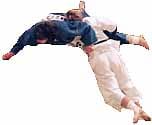If you have a Judo club which becomes known in your area, you will very probably be asked to give short public displays in connection with sporting events, festivals, and so on. It is quite useful to do this, as it provides good publicity for your club, and may bring in other members. Even when there is no financial or other reward it helps educate the public about Judo. Some clubs like to hire a local hall, and put on a display themselves, as a means of raising funds for the club and gaining publicity. Indeed, such a display might even become an annual event in your town. I shall therefore say something about the organization of displays, and give a specimen program, which has been tried out in practice by my own club. The first thing to decide in the case of a display is how long it is to last. If you are putting on a show for the organizer of some local event, make certain of the time frame to begin with. It is usually twenty minutes to half an hour that is required if the demonstration is to form part of a larger program, but 45 minutes would be ideal for many situations. Then plan the time you are allotted to show something of each of the aspects of Judo, i.e., break falling, throwing, groundwork, and self-defense, and hopefully some of the different ways in which judo is practiced (kata, shiai, randori, etc.). Let one item follow the next in some logical sequence that will give unity to your show. If you jump haphazardly from one thing to another, you may have a succession of brilliant acts, but you haven’t got a show. Unity is the keyword in production. It is best for your most capable member to plan and lead it, and then accept his decisions. If you can, appoint a commentator who knows something about Judo, so that if a mistake is made, he is not all at sea, as a result. I have seen a show in which the commentator fell behind the performers so that for each throw he named they did the next, and he was left with one over at the end. The following is a suggested thirty-minute routine with the theme that it illustrates what a student has to learn. The numbers in parentheses are the approximate number of minutes for each section. 1. Breakfalls (1) It is possible to increase or decrease the length of the program by varying the number of throws demonstrated in each section. Throws can, if desired, be demonstrated twice, the first time slowly so that the commentator can explain it to the audience, and the second time quickly as the throw is normally done. It is not advisable to have too much randori, which tends to become boring to an audience who have not seen Judo, since they cannot appreciate what the contestants are trying to do. Self-Defense is often a popular item with an audience, and if you have a lady member who can do it with a male attacker, your show is assured of success. Children are also popular with an audience, particularly if they are seen to throw adults. The aim of a display should be educational, to show the audience something of what Judo really is, and not just to amuse them, but if it is entertaining as well, it is more likely to succeed in its object.  “The serious Judo exponent trains every day.” |
| |


